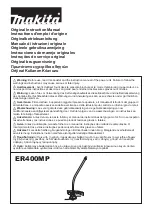
5
Periodically, the swarf (metal and ceramic dust) created during sharpening needs to be cleaned
out. Please see “Cleaning the Sharpener” on page 13.
Never operate the sharpener from the back side.
Use just enough downward pressure when
sharpening to ensure uniform and consistent contact of the blade edge with the abrasive disks
on each stroke (see Suggestions, page 12.) Additional pressure is unnecessary and will not
speed the sharpening process. Avoid excessive cutting into the plastic enclosure. Accidental
cutting into the enclosure however will not functionally impact operations of the sharpener or
damage the edge.
Try a practice pull through the sharpener with the power “OFF”. Insert a steel knife blade
smoothly into the left slot between the left angle guide of the Stage 1 (Figure 4) and the plastic
knife holding spring. Do not twist the knife. Move the blade down in the slot until you feel it
contact the diamond disk. Pull it towards you lifting the handle slightly as you approach the
tip. This practice pull will give you a feel for the spring tension. Remove the knife and read the
following instructions specific to the type of knife you will be sharpening.
Figure 3. Typical edge cross section, illustrating the 15°
primary facet.
Figure 2. A typical ceramic kitchen knife.
Handle
Edge
Choil
Tip
Model 15 edge
30°
15°
Primary
Facet
Figure 4. Stage 1 sharpening of a metal knife.






































